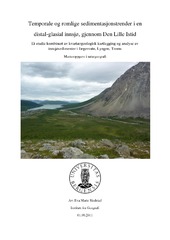| dc.description.abstract | The sedimentation processes in an arctic distal-glacier fed lake Jægervatn (3 m. a.s.l.), located in northern Norway, has been studied by means of core analysis in addition to quaternary mapping of the catchment area of Jægervatn. The cores consist of six HTH - sediment cores (JVS104 - JVS604) and one longer piston core (JVP203), retrieved along a south - north oriented transect in the lake covering ~2000 m. The physical properties of the lacustrine sediments have been examined including visual log, X-ray, X-ray fluorescence (XRF), magnetic susceptibility (MS), frequency and temperature susceptibility (χbulk, 293K and 77K), loss on ignition (LOI), water content (WC), dry bulk density (DBD) and grain size distribution. The main focus was to study the temporal and spatial distribution of sediments in Jægervatn and assess to what extent the observed patterns could be related to glacial and extra-glacial activity. Based on result from the laboratory methods a sedimentation model for Jægervatn has been developed. The analysis of the cores have recognized two dominating sedimentary units in Jægervatn; unit B which is dominated by paraglacial processes and unit A which is dominated by glacial activity. Unit B was deposited during the Medial Warm Period" (MWD), whereas Unit A was deposted during the Little Ice Age (LIA). The latter period started in 1490 AD and lasted until 1920AD in the study area, possibly with two separate advances occurring around 1660 AD and 1830 AD, respectively. A third unit is also revealed and has been deposited during marine environments when Jægervatn was connected to fjord settings. The Equilibrium-line-altitude (ELA) lowering during the LIA was 57m, but even so it lead to over a trippeling of the sedimentation rate as recorded in Jægervatn, although the spatial pattern was much the same as during earlier periods. | en_US |
